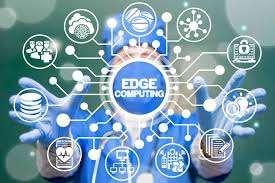As our world becomes more connected through autonomous cars, wearable health monitors, smart cities, and industrial robots, traditional cloud computing is struggling to keep up. In these systems, sending all the data to distant data centers introduces delays, consumes bandwidth, and can even pose security risks. That’s why Edge Computing is emerging as a game-changing solution.
It’s not just a buzzword but it’s the backbone of the next era of real-time, intelligent, and localized digital experiences.
What Is Edge Computing?
At its core, edge computing is a modern computing model that brings data processing and storage closer to the point where data is generated right at the "edge" of the network. Instead of relying entirely on faraway cloud servers, edge systems analyze and act on data locally, whether it’s on a smart camera, a factory floor, or a traffic sensor.
This means:
- Faster responses
- Less internet dependency
- More efficient bandwidth usage
- And improved privacy

How It Works?
Imagine a smart city full of cameras, sensors, and connected vehicles. These devices constantly generate data. Instead of sending all that raw data to a central cloud, edge computing allows it to be processed on-site or in nearby mini data centers.
Only the important insights like alerts or summaries are sent to the cloud. This reduces network load and enables instant decision-making, which is critical in scenarios like emergency response, real-time navigation, or medical monitoring.
Why It Matters?
Edge computing is not just a performance upgrade but it’s a necessity for the future. Here’s why:
- Lower Latency: Instant reaction is essential in fields like autonomous driving, telesurgery, or AR/VR. Edge eliminates the wait time of cloud round-trips.
- Reduced Bandwidth Costs: Local processing filters out noise, so you're not sending petabytes of raw data to the cloud unnecessarily.
- Resilience and Reliability: Edge systems can continue functioning even with patchy internet or offline scenarios.
- Improved Security: Sensitive data stays closer to its source, minimizing the risk of exposure during transmission.
Edge Computing in the Real World
You’re already surrounded by edge technology, even if you don’t see it.
In transportation, edge powers real-time decisions in self-driving cars. In healthcare, it supports life-saving alerts from wearables and smart medical devices. In retail, it drives personalized in-store promotions based on real-time customer behavior. Agriculture uses it for automated irrigation, while energy companies monitor remote grids instantly.
Whether it’s drones scanning farmland, a smart speaker adjusting your lights, or a content provider reducing video buffering, edge computing is behind the scenes, making it all seamless.

Big Tech Is Already Betting Big
Major cloud providers have already recognized edge as the next big thing:
- AWS Wavelength enables ultra-low latency apps by bringing compute power closer to mobile users via telecom networks.
- Microsoft Azure Stack Edge empowers businesses to deploy AI and analytics on-premise.
- Google Cloud Anthos makes managing applications across edge and cloud environments easier than ever.
These platforms are blurring the line between centralized and decentralized computing and enabling developers to build for both.
Edge AI: Intelligence Where It’s Needed Most
One of the most powerful evolutions in edge computing is Edge AI- where artificial intelligence runs directly on edge devices. Imagine a drone identifying crop diseases mid-flight, or a camera detecting intrusions in real time without needing to ping a server.
This is the future: smart, self-reliant systems that don’t wait for instructions rather they act instantly.
What’s Next?
With 5G networks rolling out globally, edge computing will only grow faster, smarter, and more capable. Expect everything from cloud gaming to industrial automation to benefit from this shift. As devices become smarter and our demand for real-time responsiveness increases, edge computing is no longer a “nice to have”, it’s becoming the new normal.
Edge computing isn’t just changing how we process data. It’s changing how we live, move, and interact with technology. And it’s happening now, right at the edge.


Discussion
Start the conversation
No comments yet
Be the first to share your thoughts on this article. Your insights could spark an interesting discussion!